I had done my homework about Ios and thought that three days would be enough to broadly visit it, but in the end, I had four days, which only made me happy because as small as it is, Ios has a lot to show.
Including, on our accommodation's website, a four-day span is considered enough for a vacation on the island, and a hypothetical itinerary was offered, day by day.
We didn't follow it, we made our own schedule to explore the island far and wide, especially since we had a car at our disposal, an almost new Peugeot 206 (7,100 km) rented for 35 €/day from autoUnion agency, a service facilitated by our hosts at Relux’s Hotel.
On the day of arrival in Ios, after settling in and quenching our hunger, we eagerly went to the nearby beach, Yalos. We had missed swimming, just spending a bit at the beach because in Santorini we didn't have that, but other physically demanding activities.
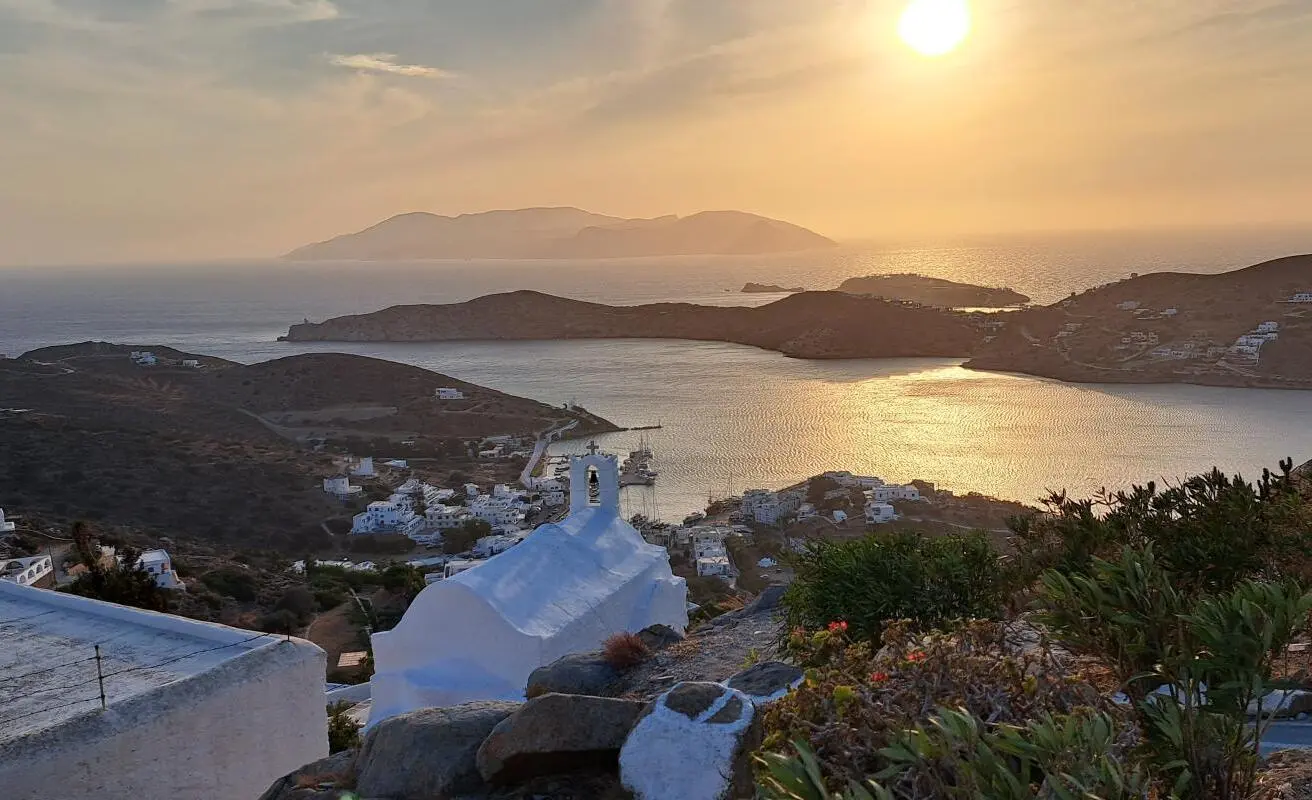
By evening, we were looking forward to getting to know Chora, the island's capital, and witnessing our first Ios sunset. But, let me start telling the story, not before saying...
... a few words about the island of Ios
The Ios Adventure: Discover the Island's Charms
Ios is an island part of the Cyclades archipelago, located in the South Aegean, between other Cycladic sisters: Sikinos to the west, Amorgos to the east, Thira (Santorini) to the south, and Iraklia, Antiparos, and Naxos to the north.
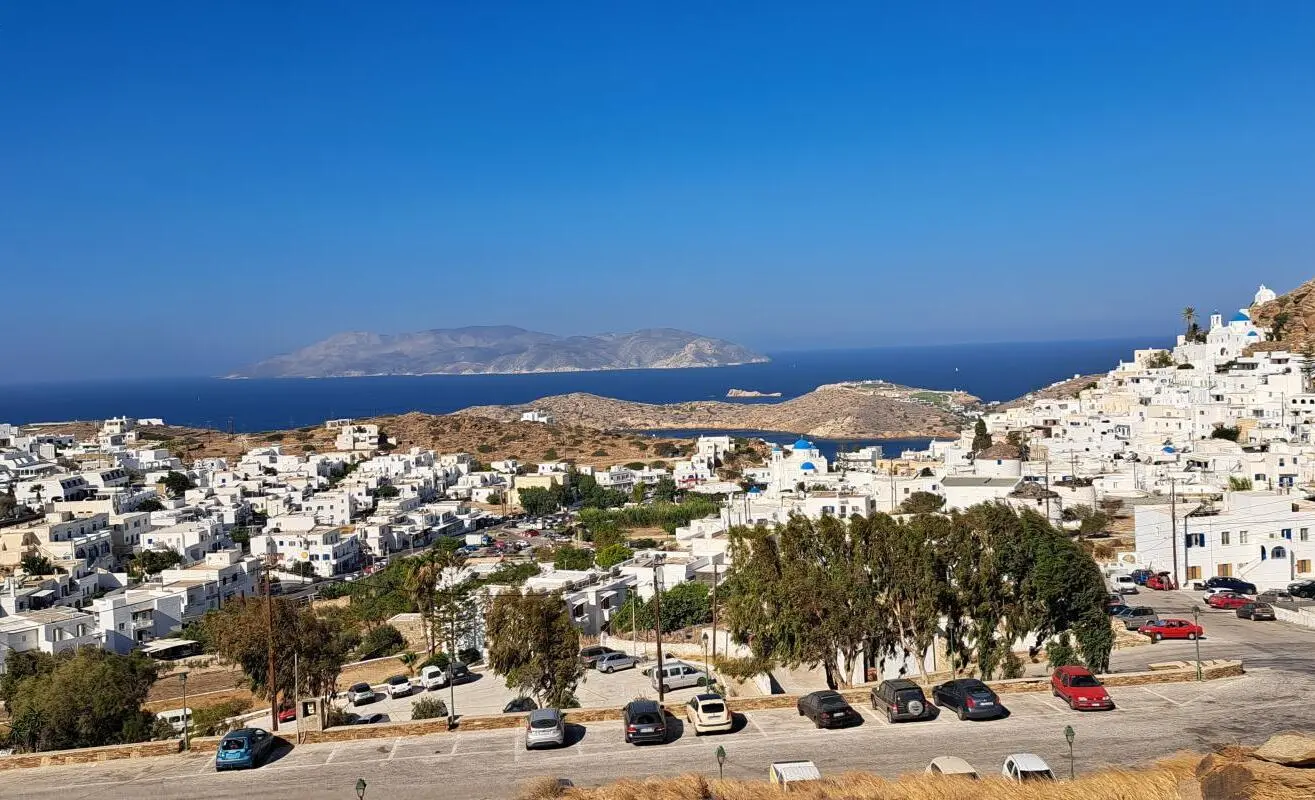
Relatively small in size (109 sq km area, 18 km length from north to south, 10 km width from east to west), Ios is an arid and rocky terrain, windswept, with Meltemi winds practically at home here, with scanty, almost non-existent vegetation.
At its highest point, the Pyrgos peak, it reaches 723 m, has paved sinuous and narrow roads in good condition, but also rugged dirt roads.
The permanent population of the island is about 2,000 residents and I can say that everyone knows everyone, often being asked by locals we interacted with where we were staying, everyone knew Olga's and, most importantly, they had only words of praise for our accommodation.

The island can only be accessed by sea, it has no airport, but it does have a helipad that can be used in case of emergencies.
The distant past reveals that a prehistoric civilization once existed on Ios, as evidenced by the Skarkos hill, which bears traces of it, followed by other civilizations: Minoan, Mycenaean. Phoenicians, ancient Greeks, Romans, Byzantines, Ottomans, and even Russians have all had their connections with Ios, until it returned to its motherland, Greece, in the last century.
Ios became very touristy and well-known when the youth declared it the island of fun, though its older renown also referred to its very beautiful beaches and highly prized local products: cheese and wine.
On the other hand, Ios is the island of Homer, actually the place where he is said to be buried, though this is not scientifically proven but rather an assumption or perhaps a myth.
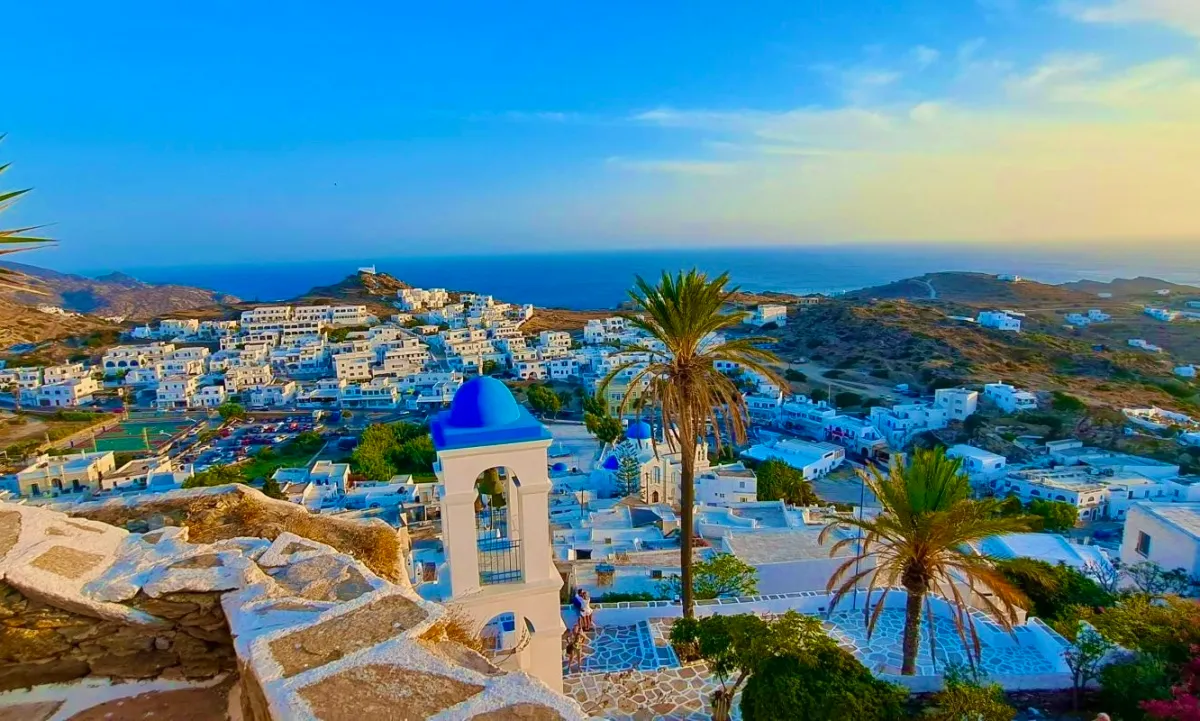
Here the blind poet is believed to have come to close his eyes when he felt the call, to rest on the island where his mother was born, a return to origins.
The Three Days Vacation on Ios Island
The first day we had the rental car, we planned it for the historical sites of the island, specifically the archaeological site Skarkos and Homer's tomb in the first part, then a free schedule for splashing around, in the south at Manganari beach.
Skarkos is a small ancient site, prehistoric I would say, located near the capital. For the 8 € paid for tickets, I can't really say that I felt it was justified for the few stacked stones seen and a couple of alleys, but for its significance as scientific evidence of the island's first inhabitants, I considered it still worthwhile.

Then, we hurried towards Homer's tomb which represents, perhaps, the most important point of interest for tourists in Ios, practically a must-see, although there's not much to see there either.
Located at the extreme north of the island, about 15 km from the capital, Homer's tomb is a place where we arrived in half an hour on a winding road with many ups and downs, in a fiercely blowing wind.
We stopped along the way at another local attraction: the four marble statues on the side of the road, one of which represents the backside of a person (Kulozis), we took photos and moved on.
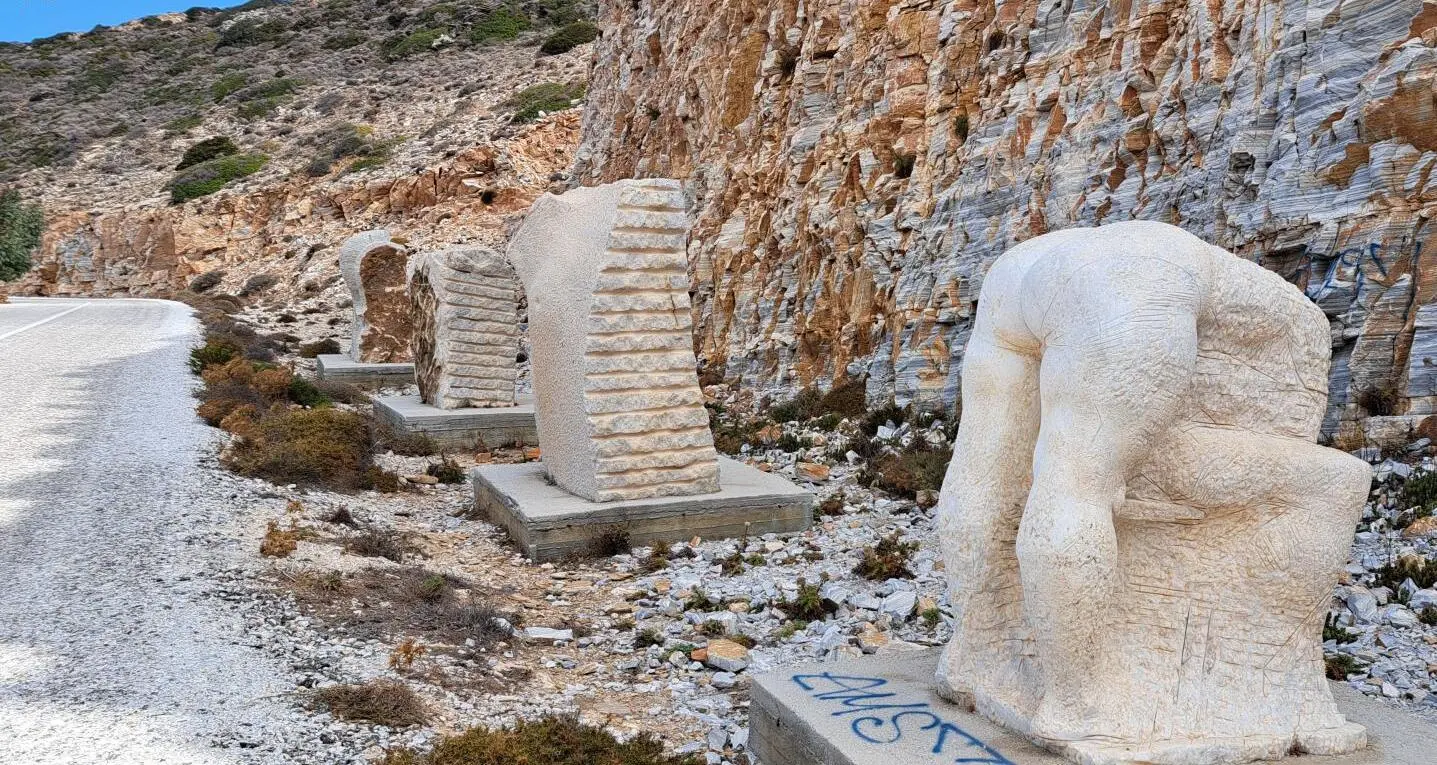
At Homer's tomb, everything is well organized: a generous parking lot to greet you, a covered terrace, a pebbled walkway from which you can see five small marble obelisks inscribed in five languages that the holy head of Homer lies there.
Then, we followed a dirt path at the end of which a small tombstone with the poet's face engraved on it announces that this is the place where the great poet of antiquity sleeps his eternal sleep. From there, the view towards the islands north of Ios takes your breath away.

Regarding Homer, every year on May 15th in Ios, the Omiria festival is held celebrating the famous author of the Odyssey and Iliad, during which participants walk the 15 km distance between the port and the tomb carrying offerings, and also an occasion for various concerts, contests, and performances.
We wanted to make a quick trip to Plakotos beach, nearby, but the wind completely discouraged us. We photographed it from above, yet with the sea all frothy, the dry sand was indistinguishable.
Afterward, we headed to Manganari beach, located at the opposite pole, giving us the opportunity to traverse the island from north to south, allowing us to see it in its entirety.

The road, full of switchbacks but well-maintained, crosses at height first the east of the island, then its center, revealing to us many landscapes with beaches, but also rocky hills, even a small reservoir.
Manganari beach is considered one of the most beautiful, if not the most beautiful beach on the island. It consists of a complex of five beaches, two of which are larger, with fine, golden sand, joined in a wide bay (approx. 2 km) which places it first in size on Ios.
The water entry is smooth, making it preferred by families with children, at the same time it's not excessively developed, so its natural aspect delights the eyes; moreover, it is considered a natural reserve with special status.

The beach, located in the south, is somewhat protected from the wind, in the sense that when the Meltemi blows, the sea does not form waves, however, it is fully felt on the sand which can be lifted and blown away, which we felt almost like a whip.
Nowhere else on the beach have I seen a cloud of dust (sand) from which I ended up with it everywhere, including in my hair, even though I had my head covered with a scarf.
In the evening, we made sure to reach Chora to walk through the labyrinthine streets of the old center, those that define it as a top Cycladic settlement.
A Few Words About Chora Ios, The Island's Capital
The capital of the island deserves a few words separately because it is the main locality, hence the name Chora, which means "village" in Greek.
Above all, Chora is also the island's most notable attraction, being a charming town where most of the population, buildings, and institutions are concentrated, famous for its vibrant nightlife in clubs, a domain for party-goers.
It is situated on two hills, which at the top, proudly carry white churches with blue domes, true Cycladic symbols, separated by a "valley" like a plateau, crossed by the road leading to Mylopotas beach.
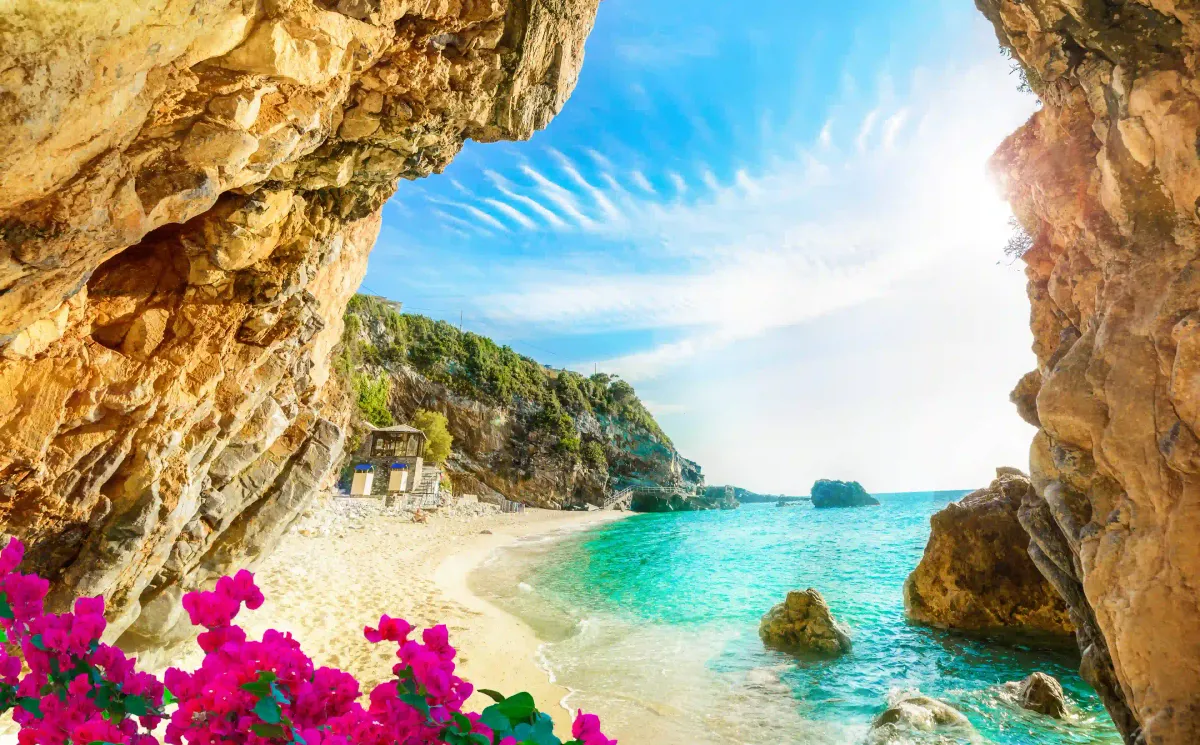
On the hills, in a rising cluster, are the white houses with blue windows, typically Cycladic, giving them the appearance of sugar cubes.
At the base, in the "valley", on either side of the road, various administrative buildings are located, the Archaeological Museum, restaurants, taverns, fuel stations, banks, and larger stores.
Among all these, the stately building of the Orthodox Cathedral stands out, attached to which is a small church, Agia Ekaterini, then a wide square, a generous parking lot, a sports field, a park, and of course, across from it, the Town Hall.
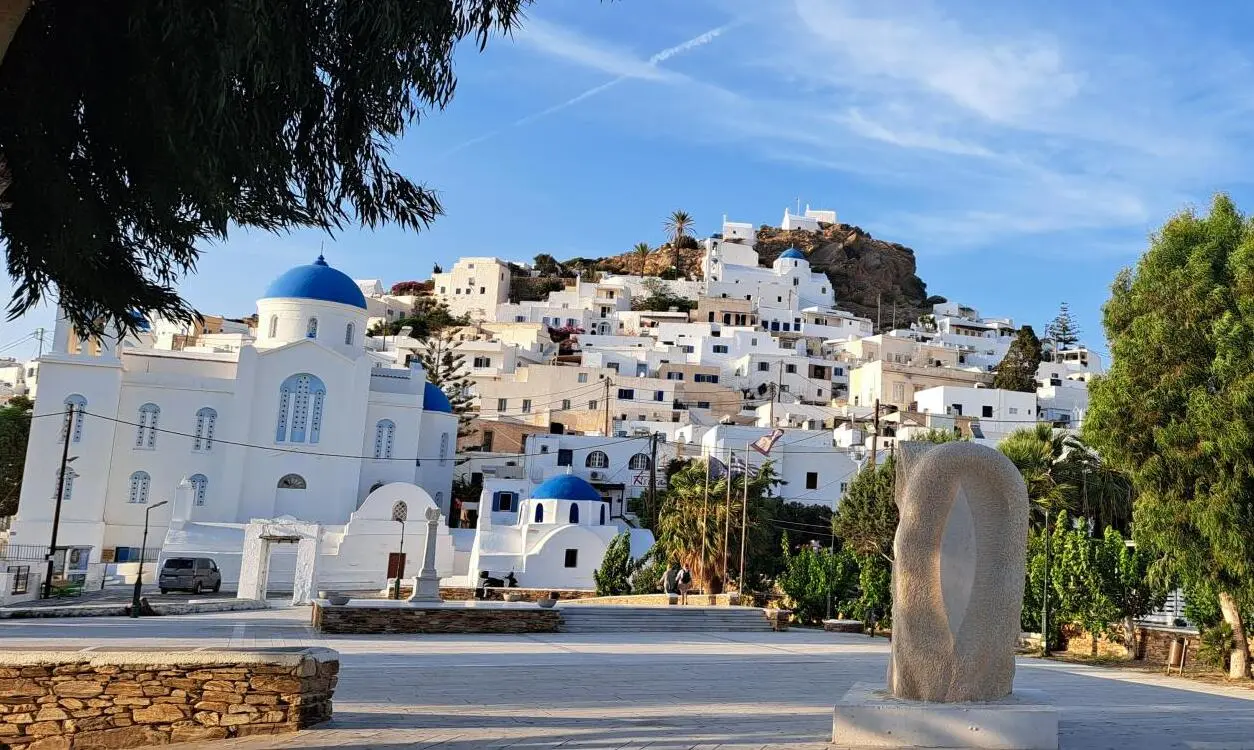
The highest hill culminates with the church of Panagia Gremniotissa, another special attraction of the town, which above it, at the top, has three more white churches: Agios Elefterios, Agios Georgios, Agios Nikolaos, the favorite places for tourists to watch the sunset.
From the first day, we got acquainted with the maze of winding, pebbled streets bordered by white houses draped in flowers, bougainvillea, chic restaurants, and fancy shops, climbing to the top where we too were mesmerized by the sunset.
This is an event you don’t want to miss, people come prepared with glasses and bottles of wine or champagne to celebrate the sun’s descent. When the Meltemi blows, up there at the top, it feels like you could be swept away, but you still don’t want to leave.
The second hill, facing the first, is topped by the church of Agioi Anargiroi and I can say that from here too, the sunset is just as beautiful, but just as windy, and the views from both are dreamlike.
On another, much lower hill crest, at the edge of Chora, stand twelve old windmills, three of which have been restored, representing another emblem of the town.
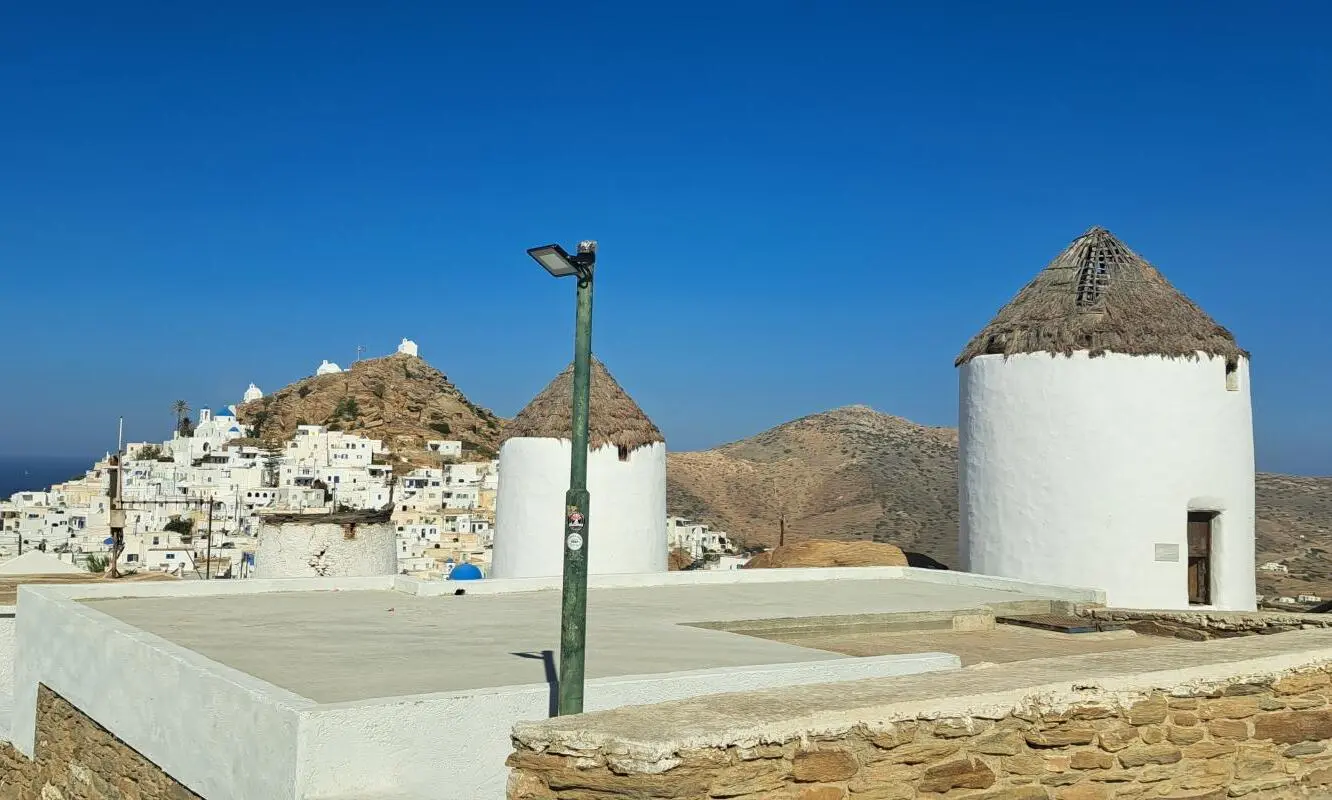
It should also be mentioned the natural harbor of the island, Ormos or Yalos, located two kilometers from the town, serving as the main link between the island and the rest of the world.
Yalos is a small settlement, a very lively place, with many taverns, hotels, markets, ticket agencies, and shops. From the port, a road with many hairpin turns leads to the capital, and the public transport, KTEL Ios, is very well organized, with frequent services and a very affordable price of 1.60 € per person per trip.
The routes end at the stunning Mylopotas beach, located in a wide bay three kilometers to the east. Mylopotas beach, another star of the island, has many facilities, is well-maintained, but this does not detract from its natural beauty: golden yellow sand, continuing into the water, gentle entry and crystal-clear water of a remarkable blue.
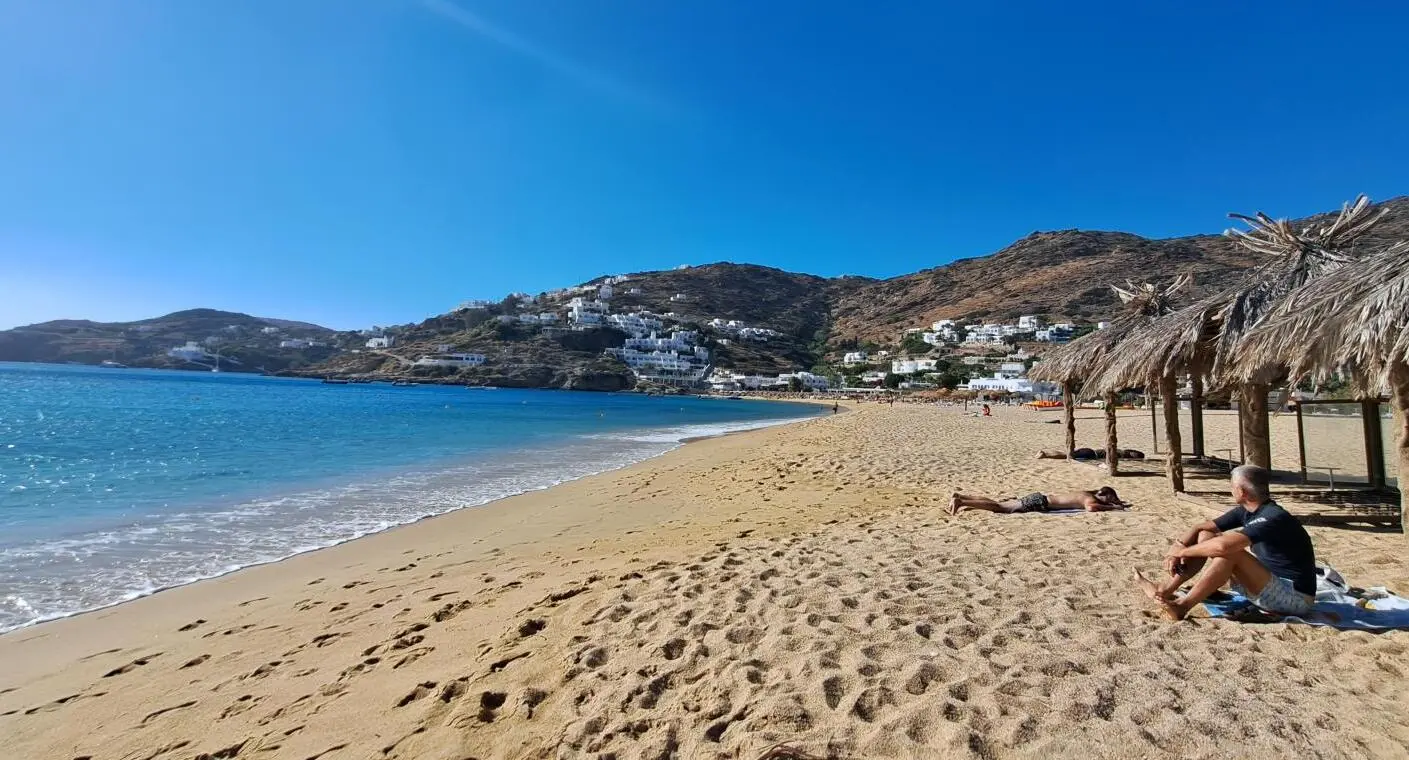
It is highly appreciated and sought after by tourists, and we too declared it our favorite, visiting it whenever we could.
The second day
The second day with the rented car began with a visit to Palaiokastro, the former capital of the island, located in the east, 17 km from Chora. Palaiokastro or Paleokastro is a former Venetian fortress built for defense purposes in 1397 at an altitude of 230 meters by Marco Crispo, one of the sons of Franzesco Crispo, who was the Duke of Naxos.
Today, on the site of the fortress, of which only partial surrounding walls remain, there is a very beautiful church, Panagia Palaiokastritissa, but even more beautiful seemed the path leading to it, although it might be considered a bit dizzying.
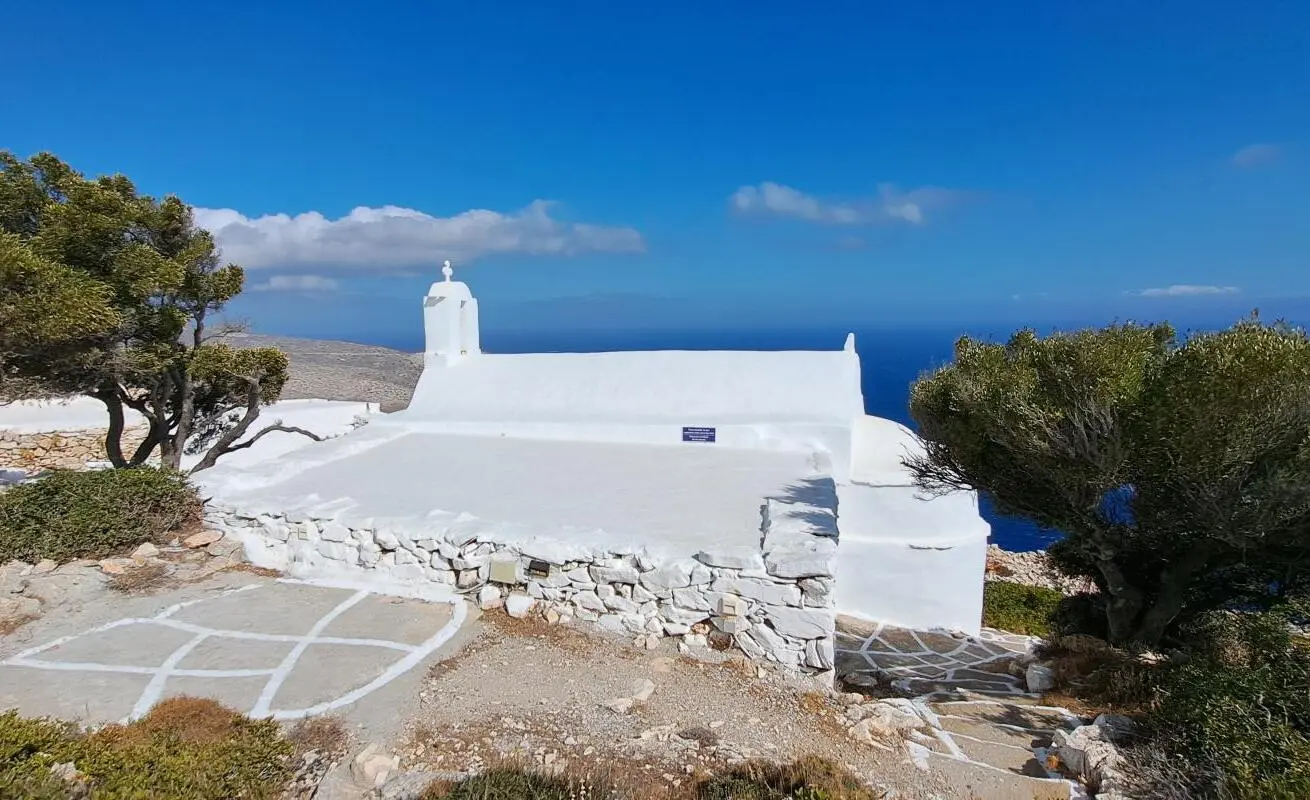
The pebbled path can be ascended on foot and is a few hundred meters long. The panoramas over the surroundings are stunning, explaining the reason why the place was chosen as a point of watch and control.
We continued with the cheesery and museum Diaseli (Cheesery & Museum Diaseli). Yes, you read that right, a cheesery! While many of you have surely heard of a winery, having experienced wine tastings in cellars or vineyards, a cheesery was something new to us. So, we were very curious to see and taste!
Address: on Agia Theodoti road towards Manganari beach
Website diaseli.com/en/
Access to the cheese museum was available every hour on the hour from 11:00 AM to 7:00 PM, every day. We signed up for the 12:00 tour, along with a French couple. The tour consisted of visiting two living rooms furnished with old items used by locals decades or even hundreds of years ago, and a review of the equally old agricultural tools displayed in the courtyard.

The most interesting part was the tasting of eight types of cheese served on a wooden platter, accompanied by a tomato salad, a bowl of honey, and two carafes of wine.
The presentation and narration were handled by a young lady, Eleni, the daughter-in-law of the Haros family, wife of Dimitris, the last of his descendants, and fluent in both English and French.

The experience was not cheap at all: 20 € per person, but the cheeses and other excellent dishes were a "rainbow on the palate," as they say.
Afterward, we took a walk along the eastern coast, ultimately choosing Mylopotas beach for an afternoon in the sun. The evening was reserved for the capital, Chora, with its charming streets and another spectacular sunset.
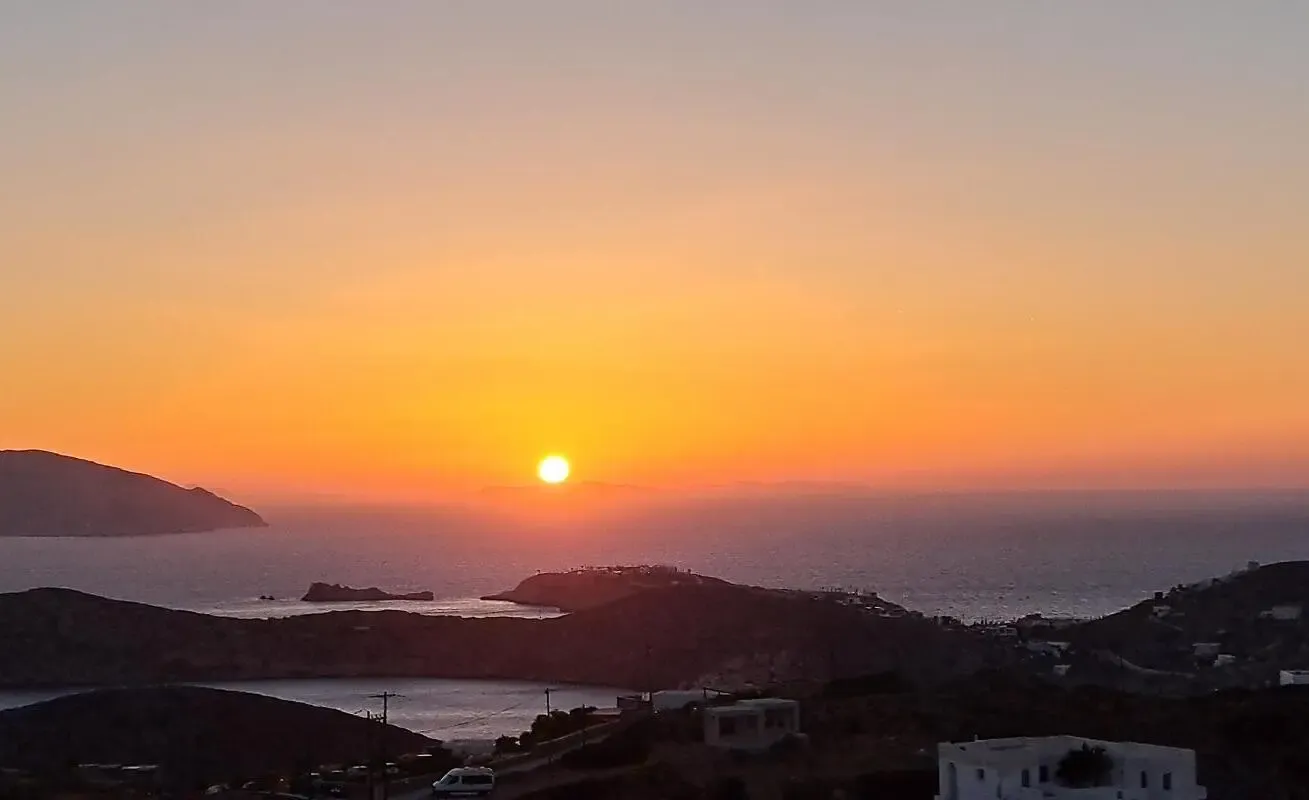
The third day
The third day was the most relaxed, and we had planned it to visit several beaches, as out of the over 35 golden sandy beaches known for their beauty, we had only seen a few, partly because the wind was causing us major problems. Nonetheless, beach-going was only possible at those in the south, but for sightseeing, more were manageable.
We also had in mind to reach near the northeastern end of Chora to see another notable site named Odysseas Elytis, a modern amphitheater built in 1997 according to the plan of an ancient structure by a German professor of architecture, Peter Haupt, a great lover and admirer of Ancient Greece.
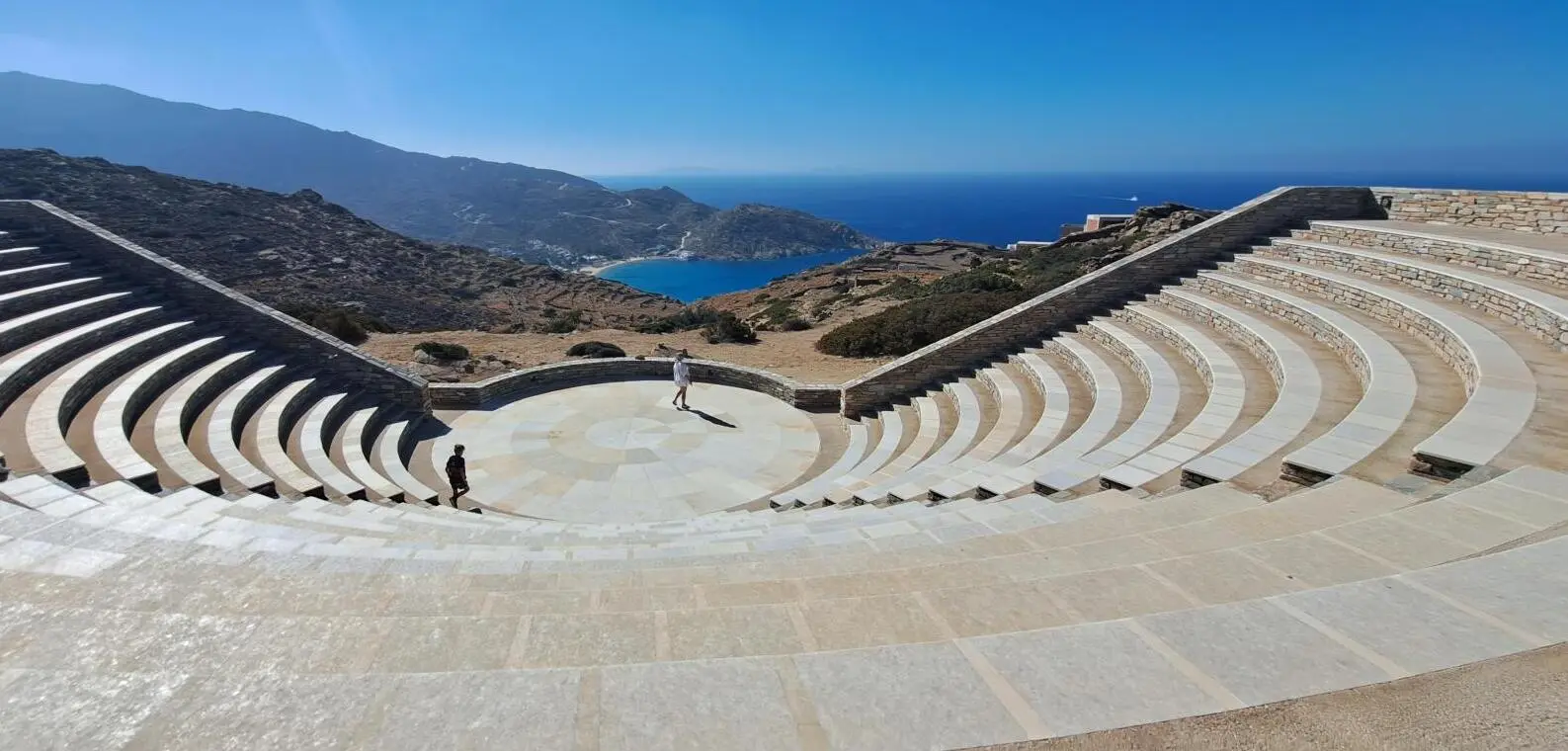
With a capacity of 1,100 people, the amphitheater, named after a famous Greek writer of our times, hosts the majority of the Iosian population during performances and festivals that take place on the island. It was designed to face the sea, specifically overlooking Mylopotas beach.
Then, we focused on the beaches, exploring both the wild and the developed ones. After a couple of splashing sessions at Yalos beach, we made a plan to review the most famous beaches on the island, aware that it was not possible to visit too many.
We started with the nearby beaches, namely to the west: Tzamaria and Koumbara, the former being a joke of a beach, while the latter deserving attention as it is popular among tourists.
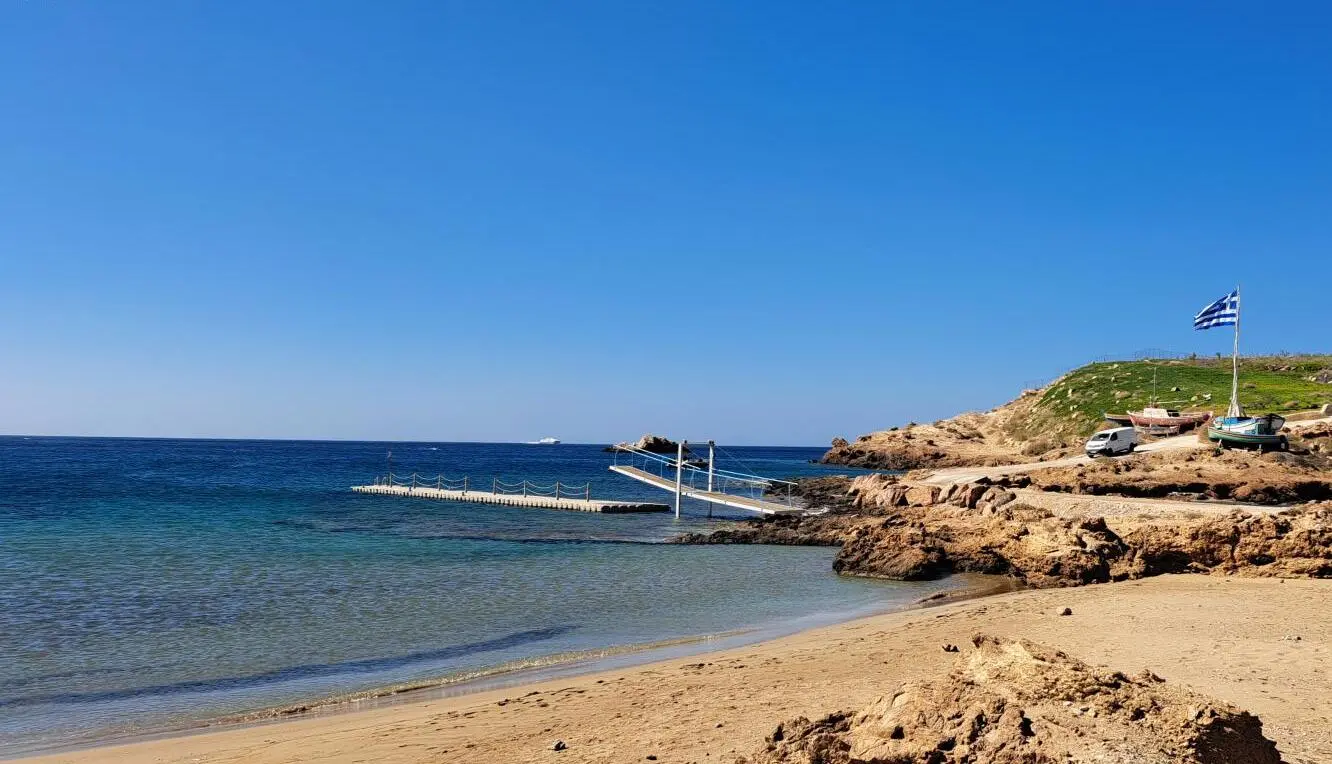
It occupies a generous bay, providing perfect shelter, and has many facilities making it quite crowded.
Continuing our tour through the west of the island, we made sure to reach Loretzaina beach, descending on a decent concrete road in switchbacks for about two kilometers from the road we had traveled several good kilometers starting from Koumbara to the north.
Loretzaina is a wild, undeveloped beach, located in a small but very picturesque bay. When we arrived, the wind was making its presence felt, stirring the sea into waves that were not to our liking.

From there, back on the road, we turned towards the east of the island, heading towards Agia Theodoti beach, another natural beauty, very famous, which we decided was better viewed from above due to the wind that was giving us no peace. It is located 14 km from the capital.
Agia Theodoti beach is about 400-500 m long and seems to have some facilities like sun loungers, including a tavern and a small accommodation unit, but looks tempting when the Meltemi wind is absent from the scene.
Its name comes from the nearby church, more than half a century old, built on the site of an ancient temple, and initially, it was a place of worship for the Roman Catholics on the island.
We continued our beach hunt to the east reaching Psathi beach, located about 18 km from Chora, nestled in a smaller but very picturesque bay, bordered by steep slopes.

The wind didn't allow us to swim there either, but we stepped onto its silk-like soft sand. The waves were choppy, so we admired it, photographed it, and from there we decided to spend our last afternoon in Ios at Mylopotas beach, not before dining at the Alonistra tavern behind it, but that's another story.
Psathi has few amenities, including a guesthouse, but it doesn't seem like a good option outside of the surfers who love it.
In the evening, we made sure to refuel the car, as per the agreement, after which we returned it to the agency, considering that it was a wonderful companion with which we traveled a little under 200 km through the island, in very good conditions.
Public Transport on Ios Island
If we hadn't rented a car, which I admit was much more convenient, there was the option to travel around the island using public transport, which operates with modern buses from KTEL Ios.
These cover the most popular destinations: Homer's tomb and Plakotos beach, Manganari beach, Agios Theodoti beach with tickets at reasonable prices. There are two to three daily services from Chora to these locations, and I noticed that private transport companies also operate to Manganari beach. In any case, the public transport system is well organized in Ios, and we could rely on it.
However, most bus routes run between the port, Chora, Mylopotas beach, or Koumbara, which is easy to understand. Tickets can only be paid for with cash, on the bus.
For those who are passionate about hiking, Ios has several marked trails for this purpose, on not too long distances that do not exceed 7-8 kilometers, of medium difficulty. From Chora, the area of the windmills, most trails start and their endpoints include Paleokastro, Agia Theodoti, and the church of Agios Prokopios, in the center of the island.
Churches and Monasteries
In the Cyclades, the Greeks have endeavored to build churches and chapels, and even monasteries at every turn, with each island, no matter how small, boasting hundreds of such places of worship, sometimes reaching the number of 365, that is one for each day of the year.
It is said to be the same in Ios, and certainly, we had the opportunity to see several during our days there, some of which I have already mentioned above. The only one I have not mentioned yet and deserves attention is the church of Agia Irini. It is located in Yalos, on one of the arms of the bay where the port is, somewhat facing the old lighthouse on the opposite side.
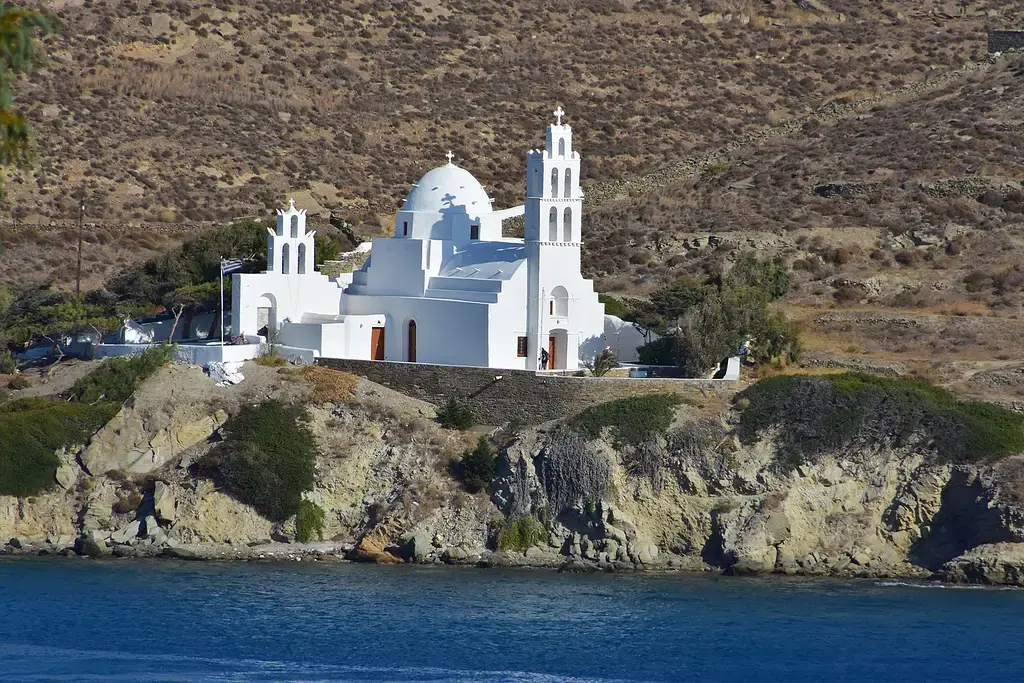
Agia Irini is exceptionally beautiful, a white Byzantine church built in the 17th century, with a distinctive feature being its two bell towers. It has a slender appearance that stands out as soon as you approach or depart from the island when you are on the water, and its not at all modest silhouette attracts all eyes.
Conclusion
I forgot to explain why I titled it "Ios, the flower island," and I will do so now at the end, stating that the simple word Ios derives from the Greek name for the violet. I discovered this detail while researching the island from various sources and liked it, adopting the expression myself.
Ios, although small and seemingly insignificant, is, in my opinion, a complete island that offers almost everything a tourist needs to relax, take walks, and enjoy extremely beautiful beaches, as well as plenty of fun.
To these are added ingredients such as good food, friendly and welcoming locals, seductive landscapes, and some historical sites, so anyone who chooses Ios will not go wrong, though they must be prepared for the disadvantage of being in the wind most of the time.
We were pleasantly surprised by Ios and had a great time there, so I recommend it to those who want to experience another Greek island in the Cyclades.
Thank you for reading and make sure to subscribe. We're constantly exploring new destinations and share our stories, tips, and the beauty we discover along the way.




